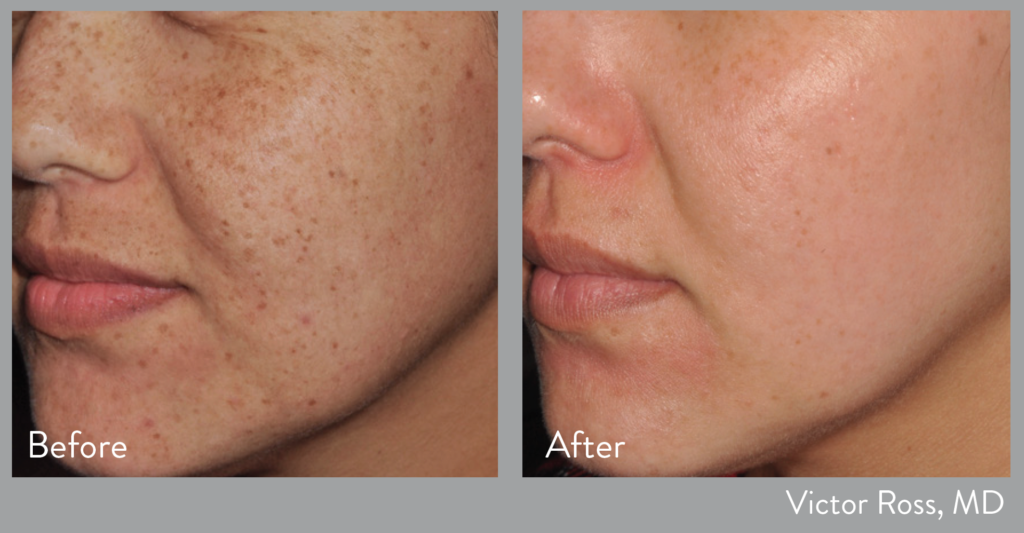
Intense Pulsed Light (IPL) treatments have been around for more than 20 years and have been effective in treating a wide range of cosmetic issues. Yet it still amazes us at how many people are unaware of this amazing technology and its wonderful benefits. An IPL is a type of laser that uses Intense Pulsed Light. Maricopa Wellness Center uses Lumecca by InMode, the gold standard in IPL technology. Lumecca is safe, powerful and effective at treating various skin issues.
What skin issues can an IPL Photofacial improve?
- Sun Damage: Being in the sunniest state comes with an extended amount of UV damage to our skin. Sun Damaged skin can be rough, dry, and have irregular coloring. Skin can lose its resilience and develop lines and wrinkles.
- Age spots or liver spots: Age spots are often a direct result of sun damage. IPL therapy improves age spots by heating and correcting dermal tissue with excessive concentrations of melanin (age spots).
- Freckles: Freckles can be beautiful but if you would prefer yours less noticeable IPL therapy can lighten them if desired. Freckles are spots that have more melanin and are darker than the surrounding skin. Sun exposure can cause freckles to darken further over time as well as create new ones. IPL therapy breaks up the dermal cells in freckles that have excessive melanin and reduces or eliminates their appearance.
- Broken blood vessels or spider veins are networks of red lines that spread across the skin and can appear on the face as well as other body parts. The light pulses from an IPL close off the flow of blood to the visible red lines and divert it to intact vessels below the skins surface.
- Rosacea: Rosacea is a common condition that causes the skin to redden on the face. Often around the nose, cheeks, chin, or forehead. As time passes the condition can grow worse and pimple like bumps can form and blood vessels become visible on the skin’s surface. IPL therapy will close off surface blood vessels, while breaking up discolored skin cells, and stimulating the development of healthy collagen rich skin.
- Acne: The most common type of acne is from oil and dead skin clogging pores. This creates blackheads, whiteheads, pustules, and in extreme cases, cysts. IPL therapy penetrates deep into clogged pores and eliminates bacteria that causes infection and inflammation while also stimulating new healthy skin growth.
- Rough skin texture: rough skin is caused by a myriad of issues from sun damage to inflammation. Utilizing an IPL can help restore a smooth complexion by stimulating collagen production in the dermal layer. This rejuvenates the surface tissue below creating a healthier and more youthful texture.
- Skin Redness: Skin redness can be caused by exposure to the wind or cold, or by a person becoming flushed easily. No matter if skin redness is caused by pigmentation problems or excessive blood flow near the surface, IPL therapy can treat the problem by closing blood vessels near the surface and breaking up cells with excess pigmentation. It also rejuvenates the skin to make it less reactive.
Best time of the year to get an IPL is in the Winter Months.
While IPL therapy is a non-surgical procedure, the skin can become highly sensitive to UV rays. Patients need to avoid sun exposure for a couple days post therapy. With the winter months Arizona experiences the lowest numbers on the UV Index and reduced daylight hours. With reduced sun exposure your skin has time to heal, regenerate, and repair from IPL therapy.
 Most people require one to three IPL Lumecca treatments to reach desired results. There is minimal down time associated with the treatment. Most clients can go about their day or back to work in 24 hours. The IPL treatment is comfortable and takes less than an hour.
Most people require one to three IPL Lumecca treatments to reach desired results. There is minimal down time associated with the treatment. Most clients can go about their day or back to work in 24 hours. The IPL treatment is comfortable and takes less than an hour.
Please give our office a call at (520) 464-6193 for a free consultation and to see if an IPL is right for you.
520-464-6193
MaricopaWellnessCenter.com
41600 W. Smith-Enke Road
Building 14, Suite 3
Sponsored content
This sponsored content was first published in the December edition of InMaricopa magazine.













![Alleged car thief released without charges Phoenix police stop a stolen vehicle on April 20, 2024. [Facebook]](https://www.inmaricopa.com/wp-content/uploads/2024/04/IMG_5040-218x150.jpg)



